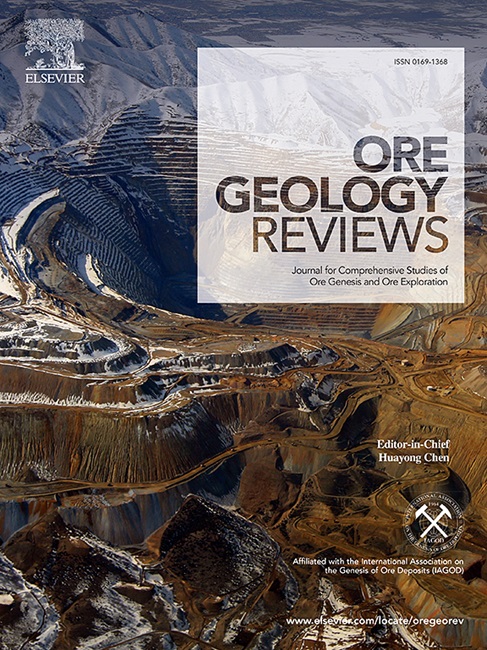Biotite and apatite geochemistry of granites from the Caledonian Debao Sn-Cu deposit, South China: Implications for petrogenesis and mineralization
IF 3.2
2区 地球科学
Q1 GEOLOGY
引用次数: 0
Abstract
The Debao Sn-Cu skarn deposit is a rare Caledonian granite-related Sn deposit in South China. The petrogenesis of the ore-related granites and the origin of the Sn-Cu mineralization in this deposit are still unclear. In this study, we present biotite and apatite chemical compositions, as well as apatite Nd isotopic compositions from the Debao porphyritic/equigranular biotite granites to constrain the petrogenesis and their potential roles in Sn-Cu mineralization. The two types of biotite granites have similar apatite εNd(t) (–7.0 to –3.7) with Nd model ages (1743–1479 Ma). Combined with the relatively high apatite Y (1746–6852 ppm) and low biotite MgO (3.97–7.58 wt%) contents, the data suggest that the granites were crust-derived, including mainly Mesoproterozoic metasedimentary rocks with some Neoproterozoic arc-related rocks input. The biotite Fe3+–Fe2+–Mg discrimination plot and the low apatite SO3 content (≤0.04 wt%) suggest low oxygen fugacity (between the FMQ and NNO buffer). Halogen (F, Cl) compositions (relatively high F and low Cl contents) in the biotite and apatite from the Debao granites resemble those of Sn deposits in South China. Biotite from the porphyritic granite has lower Li-Rb-Nb-Ta but higher Ba-V-Co-Ni contents than the equigranular granite, whilst the apatite from the porphyritic granite has lower total rare earth element (ΣREE) content than that from the equigranular granite. For zoned apatite, the ΣREE content increases from the cores to the rims. These element variations are consistent with the magma fractionation trend. The porphyritic granite has lower biotite Sn content (6.69–41.4 ppm) than that of the equigranular granite (43.6–101 ppm), suggesting that magma fractionation is critical to Sn enrichment at Debao. Given that there is no addition of mafic magma and/or its derived fluids into the crust-derived reduced magma at Debao, and that there is no Cu-rich wallrocks at Debao, we inferred that fractionation of the probable S-poor, reduced biotite granitic magmatism at Debao could generate certain Cu enrichment and small-scale hydrothermal Cu mineralization.

求助全文
约1分钟内获得全文
求助全文
来源期刊

Ore Geology Reviews
地学-地质学
CiteScore
6.50
自引率
27.30%
发文量
546
审稿时长
22.9 weeks
期刊介绍:
Ore Geology Reviews aims to familiarize all earth scientists with recent advances in a number of interconnected disciplines related to the study of, and search for, ore deposits. The reviews range from brief to longer contributions, but the journal preferentially publishes manuscripts that fill the niche between the commonly shorter journal articles and the comprehensive book coverages, and thus has a special appeal to many authors and readers.
 求助内容:
求助内容: 应助结果提醒方式:
应助结果提醒方式:


